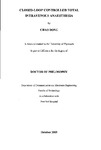CLOSED-LOOP CONTROLLED TOTAL INTRA VENOUS ANAESTHESIA
| dc.contributor.author | DONG, CHAO | |
| dc.contributor.other | Faculty of Science and Engineering | en_US |
| dc.date.accessioned | 2013-10-21T11:15:33Z | |
| dc.date.available | 2013-10-21T11:15:33Z | |
| dc.date.issued | 2003 | |
| dc.identifier | NOT AVAILABLE | en_US |
| dc.identifier.uri | http://hdl.handle.net/10026.1/2253 | |
| dc.description.abstract |
Anaesthesia is important for both surgery and intensive care and intravenous anaesthetics are widely used to provide rapid onset, stable maintenance, and rapid recovery compared with inhaled anaesthetics. The aim of the project on which this thesis is based was to investigate a reliable and safe methodology for delivering total intravenous anaesthesia using closed-loop control technology and bispectral analysis of human electroencephalogram (EEG) waveform. In comparison with Target Controlled Infusion (TCI), drug effect is measured during drug infusion in closed loop anaesthesia (CLAN). This may provide superior safety, better patient care, and better quality of anaesthesia whilst relieving the clinician of the need to make recurrent and minor alterations to drug administration. However, the development of a CLAN system has been hindered by the Jack of a 'gold standard' for anaesthetic states and difficulties with patient variability in pharmacokinetic and pharmacodynamic modelling, and a new and generic mathematical model of a closed-loop anaesthesia system was developed for this investigation. By using this CLAN model, investigations on pharmacokinetic and pharmacodynamic variability existing in patients were carried out. A new control strategy that combines a Proportional, Integral, Derivative (PID) controller, bispectral analysis of EEG waveform and pharmacokinetic/ pharmacodynamic models was investigated. Based on the mathematical model, a prototype CLAN system, the first CLAN system capable of delivering both hypnotics and analgesics simultaneously for total intravenous anaesthesia, was developed. A Bispectral Index (BIS), derived from power spectral and bispectral analysis on EEG waveform, is used to measure depth of anaesthesia. A supervision system with built-in digital signal processing techniques was developed to compensate the non-linear characteristics inherent in the system while providing a comprehensive protection mechanism for patient safety. The CLAN system was tested in 78125 virtual patients modelled using published data. Investigations on intravenous anaesthesia induction and maintenance with the CLAN system were carried out in various clinical settings on 21 healthy volunteers and 15 patients undergoing surgery. Anaesthesia targets were achieved quickly and well maintained in all volunteers/patients except for 2 patients with clinically satisfactory anaesthesia quality. | en_US |
| dc.description.sponsorship | Derriford Hospital | en_US |
| dc.language.iso | en | en_US |
| dc.publisher | University of Plymouth | en_US |
| dc.title | CLOSED-LOOP CONTROLLED TOTAL INTRA VENOUS ANAESTHESIA | en_US |
| dc.type | Thesis | |
| dc.identifier.doi | http://dx.doi.org/10.24382/4066 |
Files in this item
This item appears in the following Collection(s)
-
01 Research Theses Main Collection
Research Theses Main


